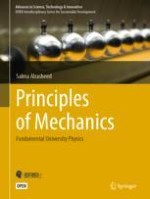Open Access 2019 | Open Access | Buch

Principles of Mechanics
Fundamental University Physics
verfasst von: Salma Alrasheed
Verlag: Springer International Publishing
Buchreihe : Advances in Science, Technology & Innovation
Open Access 2019 | Open Access | Buch

verfasst von: Salma Alrasheed
Verlag: Springer International Publishing
Buchreihe : Advances in Science, Technology & Innovation
This open access textbook takes the reader step-by-step through the concepts of mechanics in a clear and detailed manner. Mechanics is considered to be the core of physics, where a deep understanding of the concepts is essential in understanding all branches of physics. Many proofs and examples are included to help the reader grasp the fundamentals fully, paving the way to deal with more advanced topics. After solving all of the examples, the reader will have gained a solid foundation in mechanics and the skills to apply the concepts in a variety of situations.
The book is useful for undergraduate students majoring in physics and other science and engineering disciplines. It can also be used as a reference for more advanced levels.